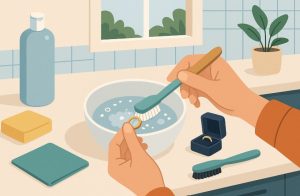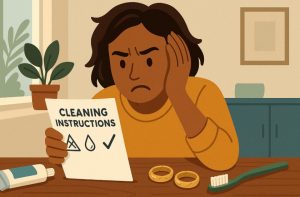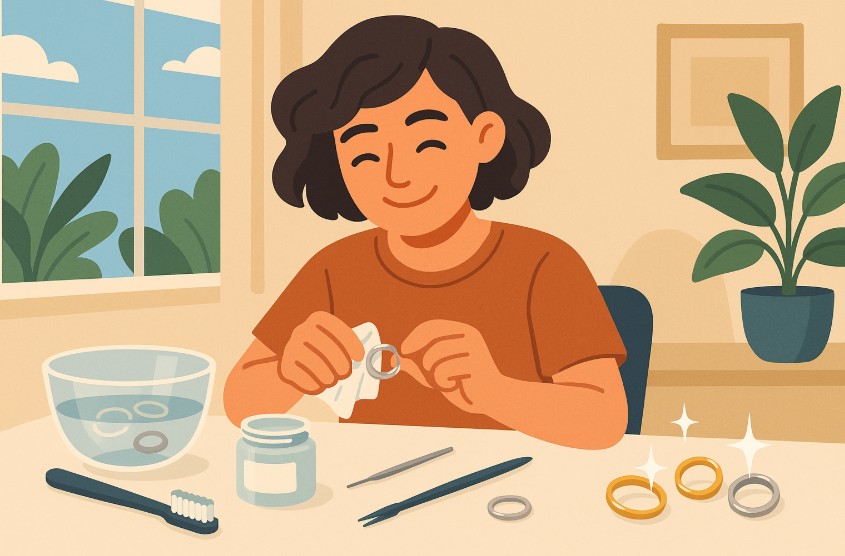Have you ever looked down at your once-sparkling ring and wondered when it lost its shine? Rings, whether they’re gold, silver, platinum, or encrusted with gemstones, are meant to sparkle, but daily life takes its toll.
Dirt, oils, lotions, and even air exposure can dull their brilliance over time. Luckily, cleaning your rings at home is not only possible but surprisingly simple when you follow the right methods tailored to each material.
This comprehensive guide will walk you through exactly how to clean rings at home safely and effectively, using items you likely already have. Whether your ring is a precious family heirloom, a diamond engagement ring, or a classic silver band, we’ve covered it all.
From homemade cleaning solutions to expert-recommended techniques for delicate stones like pearls or emeralds, you’ll learn how to restore your ring’s original shine without stepping out the door.
Why Should You Clean Your Rings Regularly?

Rings are more than just accessories, they’re often sentimental, symbolic, or valuable. Over time, even the most durable rings can accumulate layers of residue that impact both their appearance and condition.
Cleaning your rings regularly helps in several ways:
- Preserves sparkle: Dirt, lotions, and natural oils build up on the metal and under stones, dulling their brilliance.
- Prevents wear: Residue can cause abrasions or contribute to loosening of stones.
- Promotes hygiene: Rings are exposed to bacteria and grime daily, especially if worn during cooking, cleaning, or exercising.
- Extends life: Regular care helps avoid costly repairs or replacements.
Even rings made from hard metals like platinum or adorned with diamonds are not immune to the effects of grime. Soft stones, like pearls and opals, can become damaged if not cared for properly.
By establishing a gentle cleaning routine at home, you can maintain your ring’s beauty, structure, and cleanliness. Whether it’s a simple band or a complex antique setting, regular maintenance is essential to keeping it looking its best.
What Should You Know Before Cleaning a Ring at Home?
Before diving into the cleaning process, it’s essential to understand the type of ring you’re dealing with. Not all materials respond the same way to water, soap, or cleaning agents, and using the wrong method could cause irreversible damage.
Here are key things to consider:
- Know your materials: Rings can be made from gold, silver, platinum, or a mix, and each reacts differently to cleaning agents. Gold is soft, silver tarnishes, and platinum scratches easily.
- Understand the stone’s hardness: Check the gemstone’s durability using the Mohs scale. Diamonds rank highest at 10, but stones like emeralds, pearls, and opals are much more delicate.
- Check the setting: Delicate prongs or foil-back settings can trap water and weaken over time. Antique rings need special attention.
- Inspect before cleaning: Ensure stones are secure. Loose settings can worsen with brushing or soaking.
- Avoid harmful substances: Skip bleach, acetone, toothpaste, and ammonia. These can corrode metals or scratch gems.
- Use gentle tools: A soft toothbrush, a microfiber cloth, and mild dish soap are usually enough.
Cleaning without first identifying your ring’s materials and structure could cause more harm than good. With proper care and preparation, even the most delicate rings can be safely cleaned at home and returned to their brilliant state.
What’s the Safest DIY Method to Clean Rings at Home?

If you’re wondering how to clean rings at home effectively and safely, this DIY method is your go-to solution. It’s simple, affordable, and uses common household items while being gentle enough for most types of rings.
How to Create a Homemade Ring Cleaner?
A basic yet highly effective cleaning solution involves:
- Warm water
- A few drops of mild dish soap (fragrance-free)
- Optional: 1 part rubbing alcohol to 3 parts water for added degreasing
- A bowl large enough to submerge your ring
- A soft-bristled toothbrush or baby toothbrush
- Microfibre or lint-free cloth
Avoid any soaps containing moisturisers or harsh chemicals, as they may leave a film or damage the ring’s surface.
Step-by-Step: Soaking, Brushing, Rinsing, Drying
Follow this simple procedure for best results:
- Prepare the solution: Fill your bowl with warm (not hot) water and add a few drops of dish soap.
- Soak your ring: Let the ring sit in the solution for 20 to 40 minutes.
- Brush gently: Use the toothbrush to clean all crevices, focusing under the setting and around the band.
- Rinse carefully: Rinse under warm running water over a plugged sink.
- Dry safely: Pat dry with a lint-free cloth or allow to air dry.
Tools You Should Always (and Never) Use
| Tools You Can Use | Tools to Avoid |
| Soft-bristled toothbrush | Toothpaste |
| Mild dishwashing liquid | Ammonia or bleach |
| Microfibre or soft cloth | Rough paper towels |
| Rubbing alcohol (diluted) | Acetone or nail polish remover |
| Warm water | Boiling water |
This method is safe for most diamond, gold, and platinum rings. However, avoid soaking fragile stones like pearls or emeralds, and consult the specific care guide for those below.
How Do You Clean Different Types of Rings at Home?

Different metals require different care routines. Understanding how to clean each type of ring ensures you maintain their shine without causing any damage.
How to Clean Diamond Rings at Home?
Diamonds are tough but not invincible. Use warm water mixed with dish soap and let the ring soak for 20 to 30 minutes. Scrub gently with a soft toothbrush to remove grime from behind the stone and around the prongs. Rinse with lukewarm water and pat dry with a cloth.
Avoid using toothpaste or abrasive materials that can scratch the metal setting. For added sparkle, use a mix of 1 part rubbing alcohol and 3 parts water once a month.
How to Clean Gold Rings at Home?
Gold is soft and reacts to chlorine and acids. Prepare a solution with warm water and mild dish soap. Add a splash of soda water for fizzing action if needed. Soak for 15–30 minutes and scrub lightly with a toothbrush. Rinse well and dry.
Use a cotton bud for stubborn areas. Avoid vinegar or baking soda on antique gold, as they may scratch the surface or weaken the structure.
How to Clean Silver Rings at Home?
Silver tarnishes over time, so you need a bit more effort:
- For light tarnish: Warm water and soap
- For medium tarnish: Baking soda paste (3 parts soda to 1 part water)
- For stubborn build-up: Aluminium foil + boiling water + baking soda (not for antique or foil-back rings)
After cleaning, rinse thoroughly and dry with a lint-free cloth. Silver needs polishing more often than gold or platinum.
How to Clean Platinum Rings at Home?
Platinum is durable but prone to scratching. Soak the ring in warm, soapy water for 30 minutes, then gently brush and rinse. Air dry or use a soft cloth.
Avoid rough tools and chemical cleaners, which may alter the ring’s patina. Regular cleaning helps restore its natural sheen and maintain the appearance of its setting.
Using the correct method for each ring type helps preserve their quality, structure, and sparkle over time.
What About Rings With Gemstones? Can You Clean Them at Home?

Rings with gemstones are stunning but often more delicate than plain metal or diamond rings. While some stones can be safely cleaned at home, others demand extreme care to avoid damage.
Cleaning Sapphire, Ruby, and Emerald Rings
These gemstones are relatively hard and can handle gentle cleaning, but they still require caution. Soak the ring in a bowl of warm water mixed with a few drops of mild dish soap for 15 to 30 minutes.
Can You Use Soap and Water?
Yes, soap and water are safe for sapphires and rubies. Use a soft toothbrush to scrub gently around the setting and under the stone. For emeralds, avoid excessive soaking due to the presence of oil or resin in most stones. Use only lukewarm water and a soft cloth.
When to Avoid Ultrasonic Cleaners?
Emeralds, though hard, are often filled with resin or oil. Ultrasonic cleaners can cause cracks or release these treatments, leading to brittleness. Even rubies or sapphires with internal flaws should be kept away from ultrasonic machines. After cleaning, rinse the ring with clean water and dry it gently using a lint-free cloth.
How to Clean Delicate Stones Like Pearls or Opals?
Delicate stones like pearls and opals require the gentlest approach. These materials rank low on the Mohs scale and are susceptible to scratches, cracks, and chemical damage. To clean them, never soak the entire ring.
Instead:
- Dip a soft cloth in a solution of lukewarm water and mild detergent.
- Gently wipe the stone and metal band.
- Avoid soaking pearl rings, especially if they are glued into the setting.
- Do not use vinegar, alcohol, or baking soda.
Once wiped, rinse the cloth in clean water and gently go over the ring again to remove any soap residue. Dry the ring with a soft cotton cloth, avoiding any rubbing.
Pearls should always be stored separately in a padded box to prevent surface damage. Always err on the side of caution with delicate stones. If you’re ever unsure, it’s best to leave cleaning to a professional.
How Often Should You Clean Your Rings at Home?
Keeping your rings clean doesn’t mean you have to scrub them every week. The frequency of cleaning depends on the type of ring, your lifestyle, and how often you wear it.
For everyday rings such as engagement or wedding bands:
- Clean them at home once every 2 to 4 weeks using gentle methods.
- Wipe them with a soft cloth after heavy exposure to sweat, creams, or soap.
- Schedule professional cleanings once or twice a year.
For rings with delicate or antique settings:
- Limit full cleanings to every few months.
- Use a lint-free cloth to remove daily build-up.
Here’s a quick reference for recommended cleaning intervals:
| Ring Type | DIY Cleaning Frequency | Professional Cleaning |
| Diamond | Monthly | Twice a year |
| Gold or Platinum | Every 4–6 weeks | Yearly |
| Silver | As tarnish appears | Yearly |
| Gemstone rings | Bi-monthly | Yearly or as needed |
| Pearl or Opal | Only when needed | Once per year |
Frequent light cleaning helps reduce build-up and prevents the need for aggressive methods. If your ring loses sparkle or feels gritty, it’s likely time for a refresh.
Common Mistakes to Avoid When Cleaning Rings at Home

When learning how to clean rings at home, it’s just as important to know what not to do. Many common DIY mistakes can damage your jewellery, so here’s what to avoid.
- Using abrasive cleaners: Baking soda, toothpaste, and harsh scrubs may scratch soft metals and stones.
- Soaking fragile gems: Pearls, opals, and emeralds should never be submerged in water or exposed to strong cleaning agents.
- Boiling or hot water: Extremely hot water can crack stones and weaken settings.
- Not covering the drain: Many rings are lost to sink traps. Always plug or cover the drain.
- Using ultrasonic cleaners on the wrong stones: These machines are only safe for hard gems like diamonds and rubies. Avoid them for pearls, opals, and emeralds.
- Using alcohol on soft materials: Rubbing alcohol is great for degreasing diamonds, but it can harm certain stones.
- Over-scrubbing: Excess pressure with a brush can loosen prongs or scratch surfaces.
Proper cleaning keeps your jewellery beautiful. Improper methods can cost you repairs or even result in permanent damage. Take care to use the right approach for your specific ring type and always double-check before applying any cleaning agent or technique.
Should You Use Ultrasonic Cleaners at Home?
Ultrasonic jewellery cleaners have become popular at-home gadgets for restoring sparkle, but they’re not safe for all types of rings. These machines use high-frequency vibrations and liquid to dislodge dirt and grime from jewellery.
They’re ideal for:
- Diamonds
- Sapphires
- Rubies
- Platinum rings
However, they should not be used on:
- Pearls
- Opals
- Emeralds
- Vintage or foil-back rings
Ultrasonic waves can crack or loosen fragile stones, dislodge glued settings, or ruin coatings used in antique jewellery. If you’re unsure whether your stone is safe, consult a jeweller before using one of these devices.
For best results, only use ultrasonic cleaners on durable stones that don’t contain enhancements. Make sure to inspect the setting before placing it inside, and always follow the manufacturer instructions.
If your jewellery is old, cracked, or has visible inclusions, skip this method entirely and stick with gentle manual cleaning instead.
When Should You Seek Professional Ring Cleaning?

While cleaning your rings at home is convenient and cost-effective, some situations are best handled by professionals. A jeweller has the tools and experience to thoroughly clean, polish, and inspect your ring without risking damage.
Here are signs that your ring may need a professional clean:
- Dullness that doesn’t go away after multiple home cleanings.
- Delicate or intricate settings, like filigree or foil-back gemstones.
- Loose or wobbly stones that need tightening.
- Visible tarnishing or discolouration not resolved with gentle DIY methods.
- Heirloom or antique rings requiring preservation of original finishes.
- Cloudy diamonds or dull metal finishes despite gentle scrubbing.
Jewellers often use ultrasonic or steam cleaning, which can access buildup you can’t reach at home. They’ll also inspect for damage such as worn prongs, cracked stones, or misshaped bands.
Most jewellers recommend professional cleaning at least once or twice a year, and more often for daily-wear items like engagement rings.
If you truly value your piece, having it professionally inspected and cleaned from time to time is the safest way to maintain its beauty and structural integrity.
Bonus Table: Quick DIY Cleaning Guide for Different Ring Types
Sometimes, all you need is a quick guide to reference when deciding how to clean your rings at home. Use this chart to match your ring type with the safest DIY method and recommended care schedule.
| Ring Type | DIY Cleaning Method | Cleaning Frequency |
| Diamond | Soak in warm soapy water, brush with soft toothbrush | Monthly |
| Gold (yellow/white) | Dish soap and warm water, avoid vinegar or bleach | Every 4–6 weeks |
| Silver | Baking soda paste or foil-boil method for tarnish | As tarnish appears |
| Platinum | Mild soap soak, soft brush, air dry | Monthly |
| Sapphire/Ruby | Soapy water, soft brush | Monthly |
| Emerald | Lukewarm water and cloth only, no soaking | Few times a year |
| Pearl/Opal | Damp cloth only, no immersion | Only when visibly dirty |
| Antique/Vintage | Gentle cloth cleaning, avoid chemicals | Every few months |
- Use only non-abrasive tools and solutions suited to your metal and stone type.
- Avoid ultrasonic cleaners unless your jewellery is free of fragile stones or enhancements.
- Always dry with a soft, lint-free cloth and store rings in separate compartments.
This table is your at-a-glance tool for safe, at-home ring maintenance, helping you avoid costly mistakes.
Conclusion
Your rings are personal and often deeply meaningful, so keeping them clean is about more than just sparkle. By understanding the metal and gemstones used in your ring, you can apply the right at-home techniques to safely restore their shine without risk.
Whether it’s a diamond engagement ring, a vintage heirloom, or a pearl-accented band, there’s a safe, easy way to clean it at home using household items and simple care routines. But when in doubt, don’t hesitate to bring your ring to a professional for deeper cleaning and inspection.
A jeweller can help protect your piece for generations to come. Regular care keeps your rings looking beautiful and ensures they remain safe to wear. With the tips and methods in this guide, you can confidently keep your jewellery at its sparkling best, right from the comfort of your home.
FAQs
How do you clean rings naturally without chemicals?
Mix warm water with a few drops of mild dish soap and use a soft toothbrush to gently clean the ring. This method is safe for most metals and hard stones like diamonds.
Can vinegar damage gold or silver rings?
Yes, undiluted vinegar can corrode soft metals and should be avoided, especially for antique or delicate jewellery. It’s better to use mild soap and water or a baking soda paste.
Is toothpaste good for cleaning rings?
No, toothpaste is too abrasive and can scratch metal settings and gemstones. It’s not recommended for any type of fine jewellery.
How do you clean rings with diamonds without ruining them?
Use a mix of warm water and mild soap, soak for 20 minutes, and gently brush the stone. Avoid chemicals like bleach or acetone, which can damage the metal settings.
What’s the best way to remove tarnish from silver rings?
A baking soda and water paste or the aluminium foil method with boiling water is effective for heavy tarnish. Always dry the ring with a soft cloth afterward.
Are ultrasonic jewellery cleaners safe for emeralds?
No, emeralds often contain internal fractures and oils that can be damaged by ultrasonic vibrations. Stick to lukewarm water and gentle cloth cleaning.
How do I clean a ring if I don’t know the metal or stone?
Use only a damp cloth with mild soapy water and avoid soaking or brushing until you identify the material. When uncertain, consult a jeweller to prevent accidental damage.







